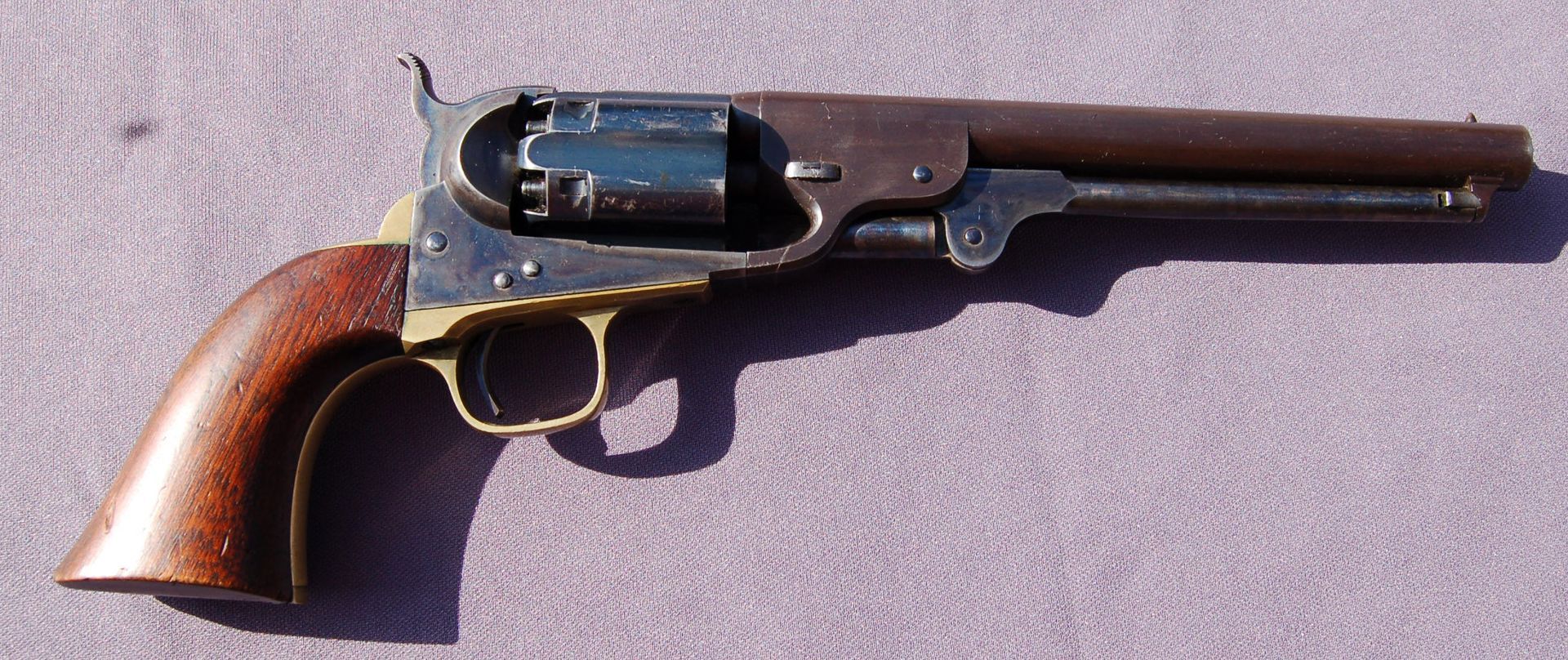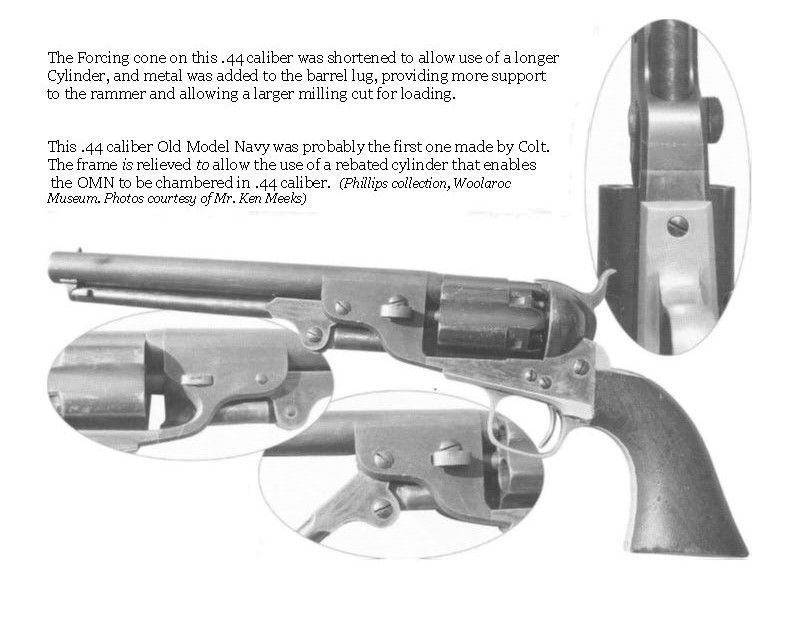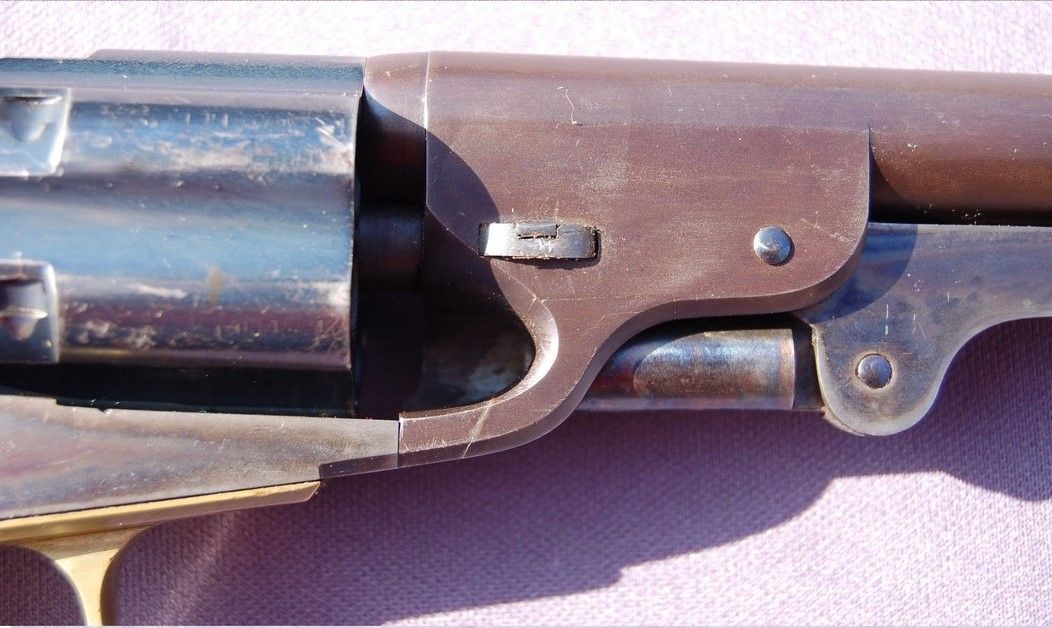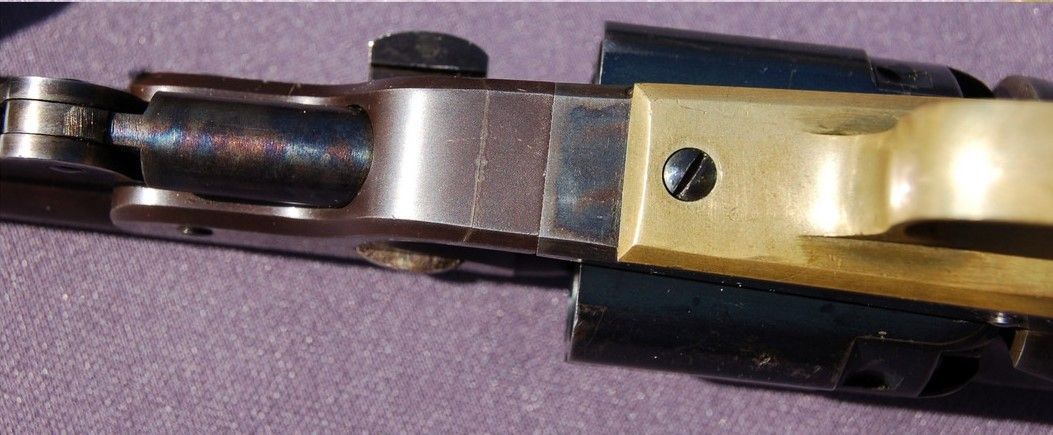COLT "PROTOTYPE" ARMY REVOLVER COPIED FROM WILLIAM B. EDWARDS' THE STORY OF COLT'S REVOLVER
In 1859, Samuel Colt delivered his last order of M1847 Dragoon pistols to the Army. These heavy pistols were built of hammered steel, a low carbon steel that was comparably weak to modern gun steel. In order to manage the pressures created by the .44 caliber bullets fired from the Army pistols, the engineers at Colt had originally designed the Dragoon pistol with a very thick barrel and even thicker cylinder. This made the pistols safe to fire, but it also made them extremely heavy. This weight problem was exacerbated by the fact the Army had also began experimenting with Colt's Navy revolver, a pistol that was nearly half the size and weight as the Dragoon due to the fact that it fired a low pressure .36 caliber bullet.
It was during this time that Colt began experimenting with what he called "Silver Spring Steel". This new steel was smelted in a blower furnace that added more oxygen to the smelting process while at the same time forcing any slag and other contaminates out of the steel. This resulted in a high carbon steel with more than three times the tensile strength of the hammered steel used in the Dragoon pistols. Colt began experimenting with the stronger steel by building up a few "light weight" Dragoon pistols with fluted cylinders and thinned out barrels. These prototype guns were lighter than the original Dragoons but were still needlessly heavy in comparison to the Navy pistols.
It was quickly decided that a new pistol would need to be designed in order to fully take advantage of the new steel. After much research and development, Colt's engineers theorized that if a stepped, or "rebated" cylinder was designed a large caliber could be combined with a small frame to make a new Army .44 caliber revolver that was a similar size and weight to the Navy .36 caliber revolvers. Colt's pattern shop quickly designed a prototype to test this theory. A new cylinder was made with the rear portion the same size as a basic Navy cylinder while the front portion was larger to provide enough chamber thickness to contain the pressures produced by a .44 caliber cartridge. The new cylinder was mounted to a Navy frame that was also rebated to allow the new cylinder to clear it. A Navy barrel was then bored to .44 caliber. Also, because the use of Colt's new steel negated the need for a beefy octagonal barrel, the new barrel was thinned out and turned completely round. As this was merely a prototype, there were no numbers or trademarks applied.
With the new prototype Army revolver in hand, Colt's engineers went to the firing range and carefully squeezed off the first few shots. Much to their relief, the small frame, large caliber pistol preformed perfectly. With the new concept proven, Colt's designers immediately went to work in developing the Model 1860 Army. This pistol would eventually become one of Colt's most succesful models, and remains virtually unchanged from the original round barrel navy prototype pistol; with the exception of a creeping ramrod developed by Elisha Root (Colt's patent expired on the Navy style rammer so Root's was implemented).
To our knowledge, the Round Barrel Colt Army Prototype pistol can only be found in one book: The Story of Colt's Revolver by William B. Edwards. When thumbing through Edwards' book one evening, Lodgewood's David Stavlo was immediately drawn to itsunique barrel and smooth lines. This set in motion a long chain of events that would eventually lead to the building of the first (and only) reproduction Colt 1860 prototype.
After studying the Army Prototype in Edwards book, David began the build by selecting a new Pietta .44 caliber 1851 Navy Revolver. This would allow the pistol's caliber to be correct right out of the gate. First, David turned the barrel round and hand filed the breech to match. He then opened up the loading port just like the original and reshaped the bottom portion of the barrel to the dimensions of Colt's prototype. Then, he replaced the cylinder with a fluted model, turning it to the proper dimensions to fit the Pietta frame. The action was then re-timed until the pistol had a nice smooth action.
David continued by defarbing the revolver; removing the markings from the frame and barrel to leave the pistol completely unmarked, just like the original. The hammer spur was re-shaped and the frame and barrel bevels were then re-cut before the entire pistol was reblued and bone-charcoal color case hardened using the same materials and techniques applied to original Colt pistols. David finished the project by re-shaping the grips to the proper dimensions and sealed them with a hand rubbed oil finish.
The finish pistol is absolutely astounding. It's a near perfect, shootable replica of Colt's original prototype 1860. We've even provided the original photo from Edwards' book for comparison. This is the first time the Colt .44 caliber Protoype has ever been produced and it is a perfect fit in any Colt enthusiast's collection. This pistol, displayed in between an original 1851 Navy and 1860 Army is the perfect "missing link" between Colt's two most successful model and would be an excellent talking point for any collector.


















